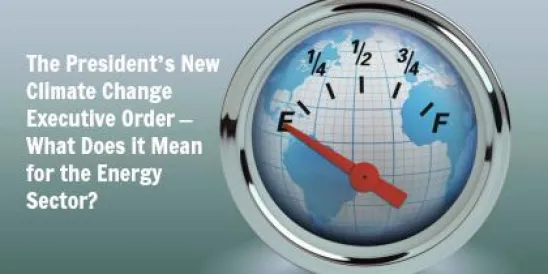President Obama issued a new climate change-related executive order on November 1, creating a new interagency Council on Climate Preparedness and Resilience and directing all federal agencies to focus on improving the nation’s ability to anticipate and adapt to changing climate conditions. The order does not create new obligations for regulated entities, but it does provide some insight into how federal environmental policies and regulations may change going forward.
The gist of the new order is that changing climate conditions – such as rising sea levels, longer, hotter summers and new rainfall patterns – can be seriously disruptive to the economy, to the nation’s infrastructure and to public welfare, and that federal agencies should focus on anticipating those disruptions and taking actions to minimize their harmful effects. More specifically, the order requires federal agencies to take a close look at whether their existing policies are helping or hurting the nation’s ability to handle changing climate conditions.
Among other provisions, the new order:
-
Directs the U.S. Environmental Protection Agency (EPA) and several other agencies to undertake an “inventory and assessment” of changes that are needed in federal water- and land-related policies, programs and regulations to “promote the dual goals of greater climate resilience and carbon sequestration;”
-
Requires all federal agencies to continue developing climate adaptation plans that identify the risks to each agency’s mission posed by climate change, and that list actions the agency intends to take to address those risks; and
-
Charges the new interagency council with coordinating the various actions required by the order.
Some of the activity contemplated by the new order is already underway. For example, in July 2013, the U.S. Department of Energy published a detailed report on energy sector vulnerabilities to climate change and extreme weather. Likewise, EPA has just released a series of draft climate adaptation implementation plans describing how the agency intends to respond to changing climate conditions. EPA is soliciting public comments on its draft plans.
Private sector entities interested in what EPA and other federal agencies are doing to respond to changing climate conditions should closely monitor each agency’s draft climate adaptation plans and consider submitting comments on those plans. One topic of potential interest is what climate change means for air-related enforcement. EPA Region 2’s draft climate adaptation plan expressly identifies increased ozone-related enforcement as a “priority action” for the region, because the agency anticipates that climate change will lead to increased ozone levels. EPA’s draft plans also suggest using EPA’s water-related and land use-related grants programs to promote climate change-resilient infrastructure rather than more vulnerable projects. Finally, energy project developers should be aware that questions about climate change preparedness may now play an increasingly prominent role in environmental reviews of their projects, such as reviews conducted under the National Environmental Policy Act.




 />i
/>i
